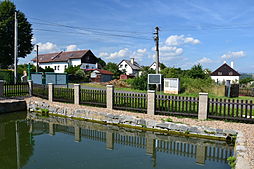Chbany
Chbany ( German Kwon ) is a municipality with 613 inhabitants ( 1 January 2004) in the Czech Republic. The place is located in 283 m asl in Okres Chomutov, eight kilometers west of Žatec, in the valley between the Eger and the Liboc.
History
Numerous findings prove that the area was already inhabited in prehistoric times. In the late Stone Age was located near an important intersection. One path led from Soběsuky about Chbany to the castle Rubin at Podbořany and in the area of Chban turned a way to Hořetice, Velemyšleves and on to Most from.
According to the History of Saaz from 1904 Chbany one of the oldest communities in the region, though the first written record dates from the 15th century. In the directory from September 9, 1422 the Saaz councilor Hermannus de Chban is mentioned. 1454 is out in the historical sources, the place in villa Chbanech 1623 Cuan and later Kwon or Qwon.
The Slavic name was derived from the second case, the town of Cheb ( alttschechisch ze CHBA ). It is believed that this population came from Cheb. This is also supported by the fact that the area was originally owned by the Forest Assen Monastery of Cheb, who colonized this area among the Cistercians.
From the Hussite Wars Chbany was, as well as the surrounding villages severely affected. Saaz slapped himself on the side of the Hussites, while Chomutov and thus Chbany were on the side of the Catholics.
Chbany lies in a fertile area in which to flourish all kinds of grain well, besides also Hops are grown. Before the First World War Chbany was a small village, with a small irregular village center, surrounded by a pond which was later converted into a fire reservoir.
Since 1960 there were important changes. By district division, Chbany came from the former Okres Žatec to Okres Chomutov. 1961 began the construction of the reservoir Nechranice that supplies the region with hot water. In the former driest area of the Czech Republic, there is now a water surface of 13 km ². With the dissipation of the water of Eger was started in October 1964, the building was completed in 1968. Under the water surface remained six villages Běšice, Čermníky, Dolany, Drahonice, Chotěnice and Lomazice. Three of them, Dolany, Drahonice and Lomazice were districts of Poláky.
For the inhabitants of the flooded villages new residential opportunities had to be provided, for which Chbany was selected. To ensure the supply, in addition to apartments were also a school, post office, shopping center, health center, a new sewerage and water supply
Community structure
The municipality consists of the villages Chbany Chbany ( Kwon ), Hořenice ( Horschenitz ), Malé Krhovice ( Kleinkörbitz ) Poláky ( Pohlig ) Přeskaky ( Presau ) Roztyly ( Rostial ) Soběsuky ( Sobiesak ) Vadkovice ( Wakowitz ) and Vikletice ( Wikletitz ) to Chbany the former towns Dolany include ( Dehlau ) Drahonice ( '' Drohnitz ) and Lomazice ( Lametitz ), which today are located below the water surface of the dam Nechranice.
The municipality is divided into the Katastralbezirke Chbany, Poláky, Přeskaky, Roztyly, nad Ohri Soběsuky, Vadkovice and Vikletice
Attractions
- Column with statue of the Madonna from the year 1715.
- Baroque chapel with a stone Madonna in 1714










